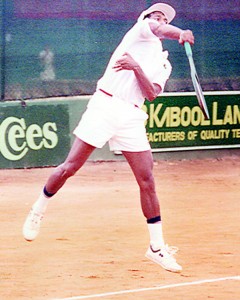Tennis anyone? The ‘Grass-roots’ idea
View(s):Do you like to play Tennis? I have rarely got a ‘no’. Tennis attracts players but has problems retaining them. The International Tennis Federation (ITF), the world body for tennis, admits that this is a worldwide trend. Still, it claims to be the sport with the largestparticipation in the world.
Tennis skills are hard to master. The service is one of the two most challenging technical and tactical arts in the realm of sports, the other being Pole Vaulting. Tennis is social, physical, mental and eventful. But then why do people walk away from tennis?
Tennis ‘made easy’
Tennis start is excessively challenging. ITF addressed this issue and introduced ‘Play-and- Stay’. In short, tennis made easy. Throwing, catching, swinging and other activities are genetic. ‘Play-and-stay’ needs only these instincts to give you instant tennis! You will play in the first minute……Ok, what is the catch? Few sentences ago I implied that tennis is ‘not easy’.

Arjun Fernando in his playing days.
Easy to master equipment
Promotion of Football used modified equipments, field and progressions successfully. ‘Play-and-Stay’ is the tennis version of it. It uses a modified court, racquet and balls. It is a ‘learn by doing it’ process. Skills are caught and not taught. In the early stages a player’s success will inspire and any failures will discourage. ‘Play-and- stay’ guarantees success and all you need are the racquets, balls and a partner; not even a court two chairs can serve as a net and it is ‘Anywhere Tennis’, fun filled all the way. More from ITF website.
Grass-roots: as interactive club activity
Tennis need five levels to mature: First, as beginners it is a self-development activity in Clubs; second, as Grass-root experience to play under challenge, also in clubs; third, as grass-root competitions, also in clubs. Once the player is comfortable in the clubs, they go into the National level ranking competitions. From there it is the international level competition for world ranking; that is ATP and WTA. All popular sports in the world have strong club contribution in the player and event development in first three stages. These are the Grass-Root level of progressions, of sport development. Clubs must consistently have strong-grass root events. In Sri Lanka we have lost the first three stages of competition which matures players. As a result players walk straight into National ranking levels, resulting in a low, national standard.
Grass-root club events

Arjun Fernando now
In a club in France there were ‘six houses’, which is a school idea. Each year, all who could play got a new house with a leader. Each house conducted four annual events. This gave 24 events and the club was active. Purpose was ‘grass-root’ participation in ‘league format’ without elimination. They had best of 3 tie breaks, 2 short sets to 3 with tiebreak at 2 all, one set with tiebreak at 4 all and handicap events. Two guests were allowed as ‘fresh bread’ for each event. Each House also had one practice day a month. It was Tennis and court side social. Members spoke about how many times they played and not as winning / loosing affair. This is Grass-Root activity. The system gave the Club a Captain and six leaders to keep the ‘Grass-Root’ activities alive.
These grass-root level expressions of Tennis are fun filled, inviting and above all ‘matures players for competition’. They serve as progressions to ‘Play-and-Stay’ in the form of ‘Compete-and-enjoy’. Competition is enjoyable if one grows with it.
League is better at Grass root level
Knock out system eliminates players league is the best for participation. Participatory Tennis boosts player’s interest. Participation will reveal that ‘tactics’ is nothing but shot-selection patterns. It makes us to ‘play-smart’.
Come back to Tennis…
If you have played before try to play 12 times in 2013. There are places to play without a big investment. Do it for life, fun and participation.
Smart players
The well respected Steffi Graff: have you analyzed her? She sighted the ball very early, had good foot work and forehand, service was effective. This is not a picture of really a great Tennis player. When she went to net, it was almost only to shake hands!
Steffi Graf in her career won the impossible ‘Grand slam’ of Tennis in 1988, ended up with 22 Majors and 62 WTA titles. Grass-root competition experience made Steffi Graf very smart. Her shot selection was 98% effective.
In the Australian open final Andy Murray lost unable to change his shot selection, but then he was playing Novak Djokovic. Really speaking, Djokovic won this title when he beat Stanislas Wawrinka in five sets and in five hours in the 4th round. Wawrinka is Swiss number two, only to Roger Federer.
In the 60’s our Clubs provided Grass-Root opportunities to players. Three SLTA secretaries saw its importance. They are Douglas Fonseka, Mahinda Dunuwila and Cedrik de Silva. From this spring board two good players went into ATP men’s World ranking. They got their ‘grass-root’ experience in our clubs. Then played National level here, India and college tennis in USA. Then they reached the World men’s rankings around 205 in the ATP. That is ‘thresh-hold’ of Grand slam acceptance. They are Arjun Fernando and Suresh Sivagnanam of Sri Lanka. Our Grass-Root starters! Anyone for Tennis?… -georgepaldano@yahoo.com-
Follow @timesonlinelk
comments powered by Disqus

















